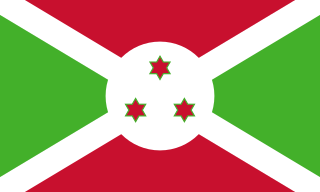Rutovu is a small town and seat of the Commune of Rutovu in Bururi Province in southern Burundi. It lies 37.1 kilometres by road to the northeast of Bururi. [1]
Rutovu is a small town and seat of the Commune of Rutovu in Bururi Province in southern Burundi. It lies 37.1 kilometres by road to the northeast of Bururi. [1]
The first three presidents of Burundi were born in Rutovu.
Rutovu receives some tourism due to nearby Mount Kikizi, [2] known as the most distant source of the White Nile. [3]

Michel Micombero was a Burundian politician and army officer who ruled the country as its first president and de facto dictator for the decade between 1966 and 1976.
The Congolese franc is the currency of the Democratic Republic of the Congo. It is subdivided into 100 centimes.

Ruanda-Urundi was a territory in the African Great Lakes region, once part of German East Africa, which was ruled by Belgium between 1922 and 1962. Occupied by the Belgians during the East African campaign of World War I, the territory was under military occupation from 1916 to 1922 and later became a Belgian-controlled Class-B Mandate under the League of Nations from 1922 to 1945. It was replaced by Trust Territory status under the auspices of the United Nations in the aftermath of World War II and the dissolution of the League but remained under Belgian control. Ruanda-Urundi was granted independence in 1962 as the two separate states of Rwanda and Burundi.

The Central Bank of the Congo is the central bank of the Democratic Republic of the Congo. The bank's main offices are on Boulevard Colonel Tshatshi in La Gombe in Kinshasa.
Eugène Jungers (1888–1958) was a Belgian colonial civil servant and lawyer. Beginning his career in the Belgian Congo as a colonial magistrate, Jungers rose rapidly through the judiciary and became the colonial governor of the League of Nations Mandate of Ruanda-Urundi from 1932 to 1946. In 1946, Jungers was further promoted to Governor-General of the Belgian Congo, the senior administrative position in the colony, which he held from 1946 to 1952.

The National Bank of Rwanda is the central bank of Rwanda. The bank was founded in 1964. The current governor of the bank is John Rwangombwa.

The Bank of the Republic of Burundi is the central bank of Burundi. The bank was established in 1966 and its offices are in Bujumbura.

The Ruanda-Urundi franc was a currency issued for the Belgian mandate territory of Ruanda-Urundi in 1960–62 which continued to circulate within its successor states of Rwanda and Burundi until 1964. The currency replaced the Belgian Congo franc which had also circulated in Ruanda-Urundi from 1916–60 when the Belgian Congo became independent, leaving Ruanda-Urundi as the sole Belgian colonial possession in Africa. With the independence of Rwanda and Burundi in 1962, the shared Ruanda-Urundi franc continued to circulate until 1964 when it was eventually replaced by two separate national currencies.

Mount Kikizi is one of the highest mountains in Burundi. Its summit is at a height of 2,145 m (7,038 ft). The mountain stands in the country's southeast, between the towns of Rutana and Kinyinya.

The following outline is provided as an overview of and topical guide to Burundi:
These are some of the articles related to Burundi on the English Wikipedia:
André Muhirwa was a Burundian politician as a member of the Union for National Progress and the First Prime Minister of independent Burundi from October 21, 1961, to June 10, 1963. He was the brother-in-law of Louis Rwagasore.

Belgium had a colonial empire in Central Africa from 1908 to 1962, comprising the colony of the Belgian Congo (1908–60) and the international mandate of Ruanda-Urundi (1916–62). The territories were the responsibility of a Belgian parliamentarian who received the title Minister of the Colonies for most of the colonial period. The exact title was changed on several occasions.

This is a survey of the postage stamps and postal history of Rwanda. The Republic of Rwanda is a landlocked country located in the Great Lakes region of eastern-central Africa, bordered by Uganda, Burundi, the Democratic Republic of the Congo and Tanzania.
Frans Hubert Edouard Arthur Walter Robyns (1901-1986), known as Walter Robyns, was a Belgian botanist. His son, André Robyns (1935–2003), was also a botanist.
Burkhart Waldecker was a German explorer who, in 1937, discovered the most southern source of the White Nile in Burundi. Waldecker came to the area to seek asylum from Nazi persecution. The true source is near Rutovu, where a pyramid was erected in 1938. Waldecker's name is seen on the plaque, which says in Latin, "Caput Nili," thus ending man's long quest to discover the source. Although the Nile river has various sources, Waldecker found the White Nile's most southern source which is part of the Kagera River, the other being Lake Kyoga in Uganda further north. The small pipe flowing with the first Nile water appears from the ground below the summit of Mount Kikizi where the pyramid is found.
The Ruzagayura famine was a major famine which occurred in the Belgian mandate of Ruanda-Urundi during World War II. It led to numerous deaths and a huge population migration out of the territory and into the neighboring Belgian Congo and surrounding areas. The famine is considered to have begun in October 1943 and ended in December 1944.

The African territories of Ruanda and Urundi came under Belgian control as Ruanda-Urundi after they were seized from Germany during World War I in 1916. They had previously formed part of German East Africa.

Jean-Paul Harroy was a Belgian colonial civil servant who served as the last Governor and only Resident-General of Ruanda-Urundi. His term coincided with the Rwandan Revolution and the assassination of the popular Burundian political leader Prince Louis Rwagasore. It has been alleged that Harroy may have been implicated in the murder.